| |
|
|
| |
Blink and you'll miss them.
Thu 1st May, 2014
|
|
|
|
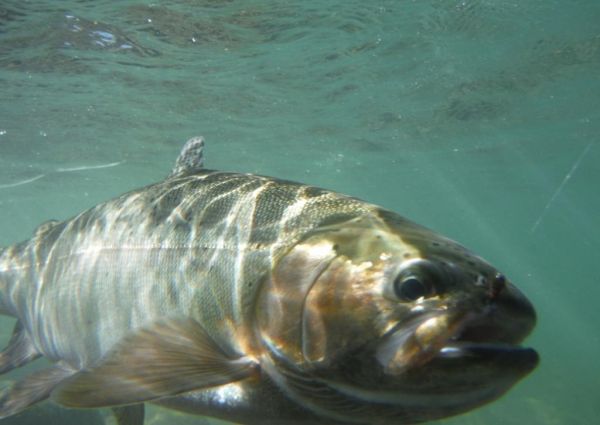
Even though we've had another week of showers with the odd torrential downpour most of the fish have stayed put in the lake. I think the flow graph crept past thirty nine cumecs at one stage but for the majority of anglers it made very little difference to the fishing.
There were a few browns caught close in while the river was carrying some color but the rest of the time a lot of anglers struggled. Some small pods went through again this week, unfortunately they were well spread out and it was a case of blink ... and you missed them.
Many anglers didn't arrive in Turangi until quite late in the holiday break ... put off traveling by the forecast for adverse weather conditionst across the country ... as usual Turangi escaped most of it.
The weekends have been busy, with a lot more fisho's trying they're luck, especially the last couple of Sundays ... but during the week the Tongariro has been fairly quiet despite the school holidays.
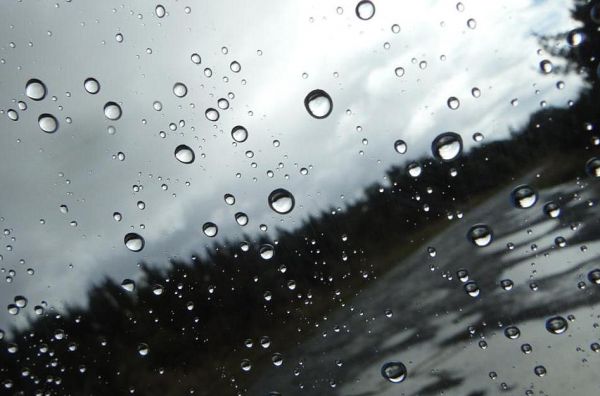
Judging by the amount of vehicles in the Bain car park on weekends, the lower river was proving popular, which makes sense if you hope to intercept any running fish first.
This whole stretch from the bridge down always gets busy at this time of year and from now on will be the first port of call for many fisho's.
There are several places in this part of the river where fish numbers become concentrated and "old hands" target these spots during the runs.
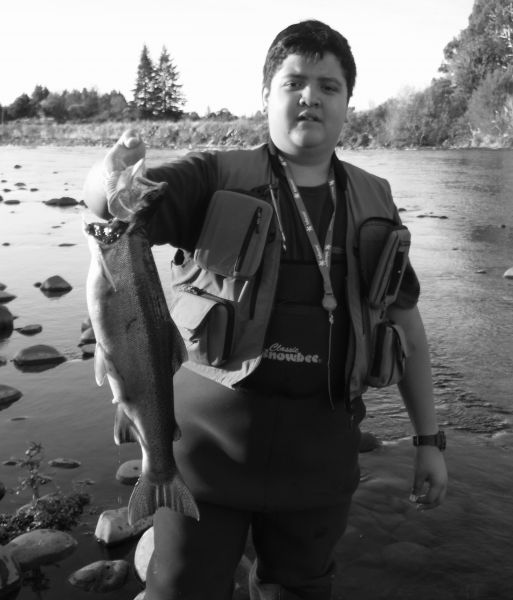 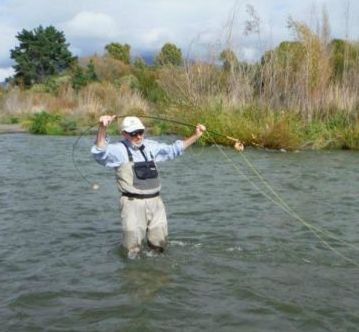
Wiramu is a regular face in the bridge pool when he's not in school and this was his second when I walked past one afternoon.
Further downstream American angler Glenn Kazo was surprised at the strength of Tongariro rainbows ... here he is "bench pressing" one in the Braids.
The stretches below town are probably the best bet at present and I've seen anglers carrying keepers there a few times.
Still some good hatches taking place mid morning and most afternoons. So if you're new to the river don't go all out on globugs yet.
I've stuck with naturals or a nymph/globug combination below the bomb.
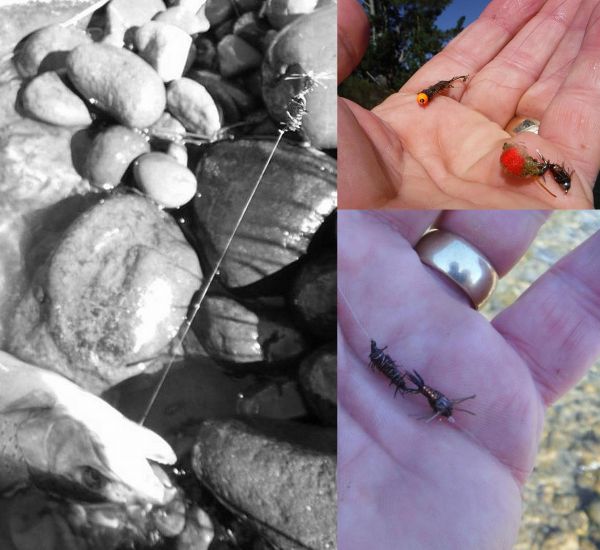
Too be honest I've done better fishing the runs and riffles with other methods.
Fishing one of these shallow runs I landed a real fluke of a rainbow.
I thought from the outset things didn't feel right and once it was on the bank I could see why.
Trailing from its mouth was about eighteen inches of tippet with a fly on the end ... my Cadillac nymph had hooked that fly.
Ten minutes later a bit further upstream the same Cadillac nymph hooked up on another leader with a bomb and globug on the end ... but this time ... no fish!
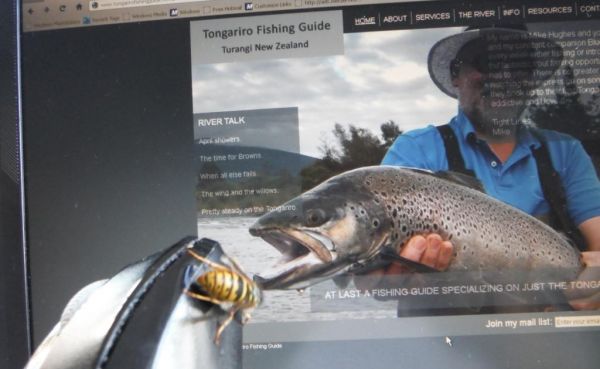
One insect I think we've all had enough of this year are those bloody wasps. They seem to be everywhere and for most people I don't think a day goes by without a "run in" with them. Below are a couple of examples that have appeared in the press recently :
* A nest containing thousands of wasps was found built around a ponga stump in a backyard in the Taranaki town of Normanby. Exterminator Neville Prestidge said it was the largest nest he had encountered in 14 years doing the job.
* Sheep farmer Janet Kelland was attacked by hundreds of wasps after stepping on a nest in a remote area northwest of Taumarunui. At one point she feared she would not survive.
Even as I'm writing this there are several buzzing around the room and one in particular keeps crawling over the keyboard and mouse.
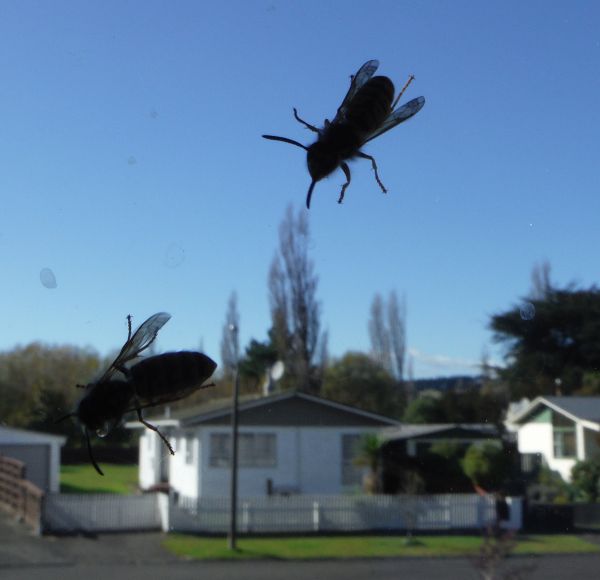
This years dramatic increase in wasp numbers has been blamed on the months of relatively dry warm weather and the rapid spread of a species of giant willow aphid.
These insects were first detected last year and produce large amounts of honeydew.
Wasps naturally feast on this stuff which is usually provided by insects native to New Zealand so this new and plentiful food source has helped sustain the growing wasp population.
There are four kinds of social wasps in New Zealand all of them unintentionally introduced and regarded as pest species.
The information reproduced below is from the Department of Conservation web-site.
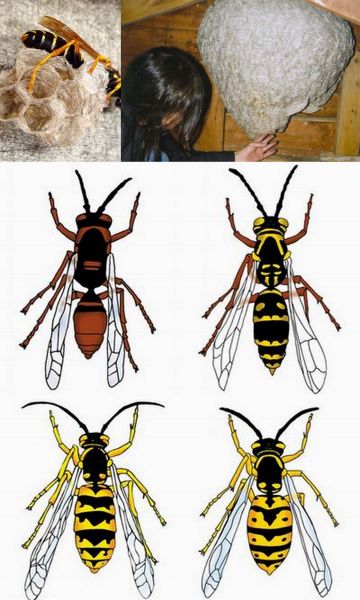
FACTS ABOUT WASPS
Social wasps live as colonies in nests of honeycomb-like cells.
The Asian paper wasp and the Australian paper wasp build small nests, about the size of a pear.
The Asian paper wasp has been found in the North Island and top of the South Island but the Australian paper wasp remains confined to the north of the North Island.
The more widespread German and common wasps live in large colonies, about the size of a soccer ball, which can become huge if they manage to survive over winter.
The German wasp was introduced with United States aeroplane parts in the 1940s and the common wasp arrived relatively recently but is now widespread.
These two are very similar in appearance, and both have the characteristic black and yellow colouration.
German wasp nests are grey. Common wasp nests are brown.
THE THREAT OF WASPS
New Zealand has some of the highest densities of common and German wasps in the world. They have no natural predators here, our winters are mild and there is plenty of food for them.
Wasps present a particular ecological problem in beech forest where they are voracious consumers of honeydew.
In beech forests there is an estimated average density of 12 nests, or about 10,000 worker wasps, per hectare. This makes the biomass of wasps in these areas higher than that of all native birds, plus stoats and rodents, put together.
Honeydew is produced by a native scale insect and is an important food for native birds, bats, insects and lizards.
Wasps also prey on insects and have even been seen killing newly hatched birds.
Wasps are a nuisance to forestry gangs, and a worry to tourist operators. They are unwelcome guests at summer picnics and barbecues.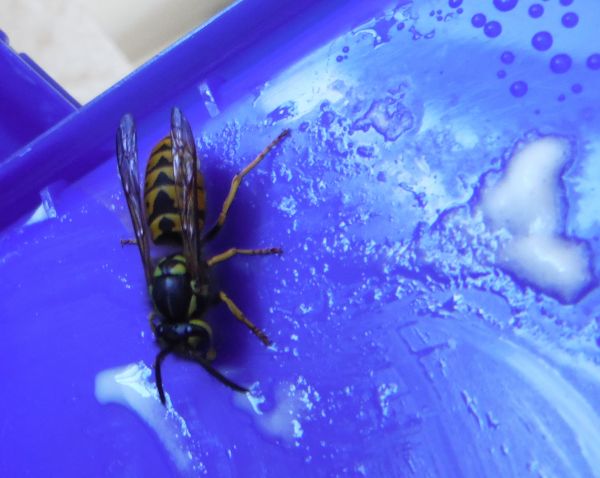
No-one finds a wasp sting a fun experience ... ask Blue he just stepped on one ... and some people can have an allergic reaction.
You can help stop wasps for more information contact your local DOC office or District Council's pest control officer.
Find your local council on the Local Government NZ website (external site)
The best way to reduce a local wasp population is to find and destroy all the nests in the area. Usually wasps fly no further than 200 meters, so you should aim to kill all the nests within this range.
HOW TO FIND NESTS
If you search on sunny days, near dawn or dusk, the low light angles will highlight the flight path as wasps enter and leave the nest. You can put out a bait of cat food sprinkled with flour which will make the wasps easier to see.
HOW TO POISON THE NEST
Place a dessertspoonful of insecticide at the nest entrance after dark when the wasps have stopped flying. You can use a puffer bottle for this job. Worker wasps flying in and out will spread the powder into the nest and the colony usually dies within a day. If activity continues repeat the treatment until wasp activity ceases.
Don't shine your torch into the nest or wasps will fly up the beam.
WHAT POISONS TO USE
There is a range of insecticides available from hardware and garden stores. These include Wasp Killer Dust and Permex Insect Dust, which have permethrin as the active ingredient, and Rentokil Wasp Killer and No Wasps Insecticidal Dust, which both use carbaryl.
Follow the safety instructions supplied with the insecticide.
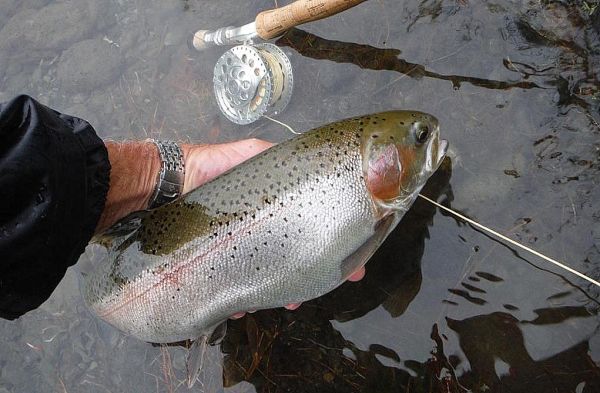 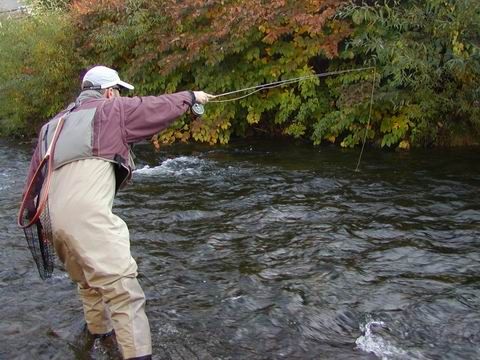
Last report there were one or two nice jacks getting caught, this week its the turn of the ladies and I've had a couple of hens that were chokka with eggs. But you had to go looking for them and it wasn't easy.
While on your travels up and down the river you may have spotted anglers catching fish doing this ... Czech nymphing.
That's because World Championship Team Gold medalist and Individual Silver and Bronze medalist Roman Heimlich is in town and he's been offering half day clinics on the method.
If you're interested pop into Creel Tackle Shop & Cafe and have a word with Grant about it.
Tight lines guys.
Mike |
|
|
| Back to Top |
|
|
|
|
| |
| COMMENTS |
|
Hi Mike,
Further to your story about wasps ... in March I noticed quite a swarm at the dry creek bed you cross when walking to Big Bend pool. I noticed them again on the way back and covered up and walked through very quickly. Anglers should take care.
I also remember a school excursion 60 odd years ago when one pupil bit on a cream bun with a wasp in it. He was stung on the inside of the mouth and was taken to hospital for emergency treatment because the swelling caused major breathing problems.
He never ate a cream bun again!
Cheers,
Murray |
|
|
|
| Muzza | Thu 1st May, 2014 | |
|
|
|
| |
|
|
|